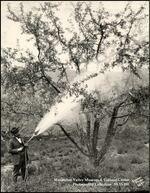
A man in a bow tie sprays an apple tree with lead arsenate. Orchardists say without the pesticide, the country’s most productive apple growing region wouldn’t have been able to grow apples.
Courtesy of the Wenatchee Valley Museum & Cultural Center
Imagine an apple, rotten at its core, pocked with worm holes and brown, pasty insect excrement spilling out the side. Now imagine an apple free of insects but coated in lead and arsenic, like a candied apple of toxic metal. Which would you rather eat?
In the 1930s that was the orchardist’s dilemma. Succumb to the codling moth and its lust for apples, or fight the pest the only way you knew how.
Today, you don’t have to make that choice. And you have the banned chemical DDT to thank in part for that.
DDT was banned in 1972 because of its harm to human health and the environment. DDT can take more than 15 years to break down in the environment, meaning it leaves a toxic trace for many years.
But when it replaced lead arsenate in the late 1940s, “DDT was the savior,” said Frank Peryea, soil scientist and professor emeritus at Washington State University.

A bag of lead arsenate on display at the Wenatchee Valley Museum & Cultural Center. The pesticide lead arsenate was introduced in the 1890s. Not long after that, Washington growers were using it to protect their apples from a crop-ruining pest.
Tony Schick / OPB/EarthFix
At that time, the codling moth was becoming resistant to lead arsenate. The only reason it had much effect by this time, Peryea said, was because orchardists were spraying so much of it that it coated the apples in a layer too thick for the moths to chew threw.
Lead and arsenic do not break down in soil. And even low doses have been linked to health problems in children, ranging from lowered IQs to increased cancer risk later in life.
DDT also ushered in a new era of discovering more effective and less toxic pest controls. One of the most effective in use today is mating disruption, in which orchards are treated with pheromones to to prevent codling moths from finding mates and multiplying in orchards.
Read the full story here.